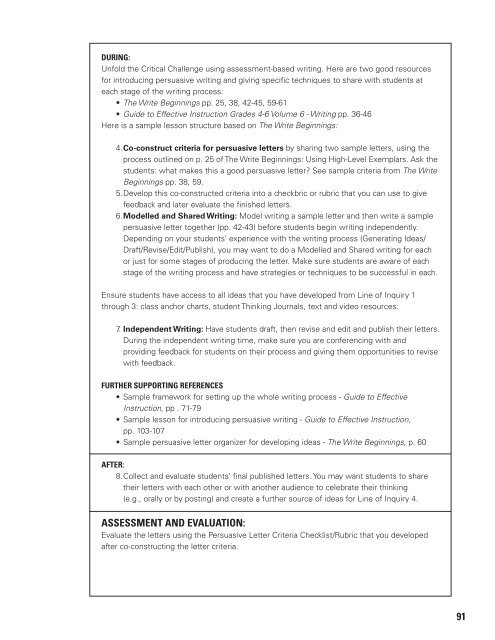Residential Residential
Residential_School
Residential_School
Create successful ePaper yourself
Turn your PDF publications into a flip-book with our unique Google optimized e-Paper software.
DURING:<br />
Unfold the Critical Challenge using assessment-based writing. Here are two good resources<br />
for introducing persuasive writing and giving specific techniques to share with students at<br />
each stage of the writing process:<br />
• The Write Beginnings pp. 25, 38, 42-45, 59-61<br />
• Guide to Effective Instruction Grades 4-6 Volume 6 - Writing pp. 36-46<br />
Here is a sample lesson structure based on The Write Beginnings:<br />
4. Co-construct criteria for persuasive letters by sharing two sample letters, using the<br />
process outlined on p. 25 of The Write Beginnings: Using High-Level Exemplars. Ask the<br />
students: what makes this a good persuasive letter? See sample criteria from The Write<br />
Beginnings pp. 38, 59.<br />
5. Develop this co-constructed criteria into a checkbric or rubric that you can use to give<br />
feedback and later evaluate the finished letters.<br />
6. Modelled and Shared Writing: Model writing a sample letter and then write a sample<br />
persuasive letter together (pp. 42-43) before students begin writing independently.<br />
Depending on your students’ experience with the writing process (Generating Ideas/<br />
Draft/Revise/Edit/Publish), you may want to do a Modelled and Shared writing for each<br />
or just for some stages of producing the letter. Make sure students are aware of each<br />
stage of the writing process and have strategies or techniques to be successful in each.<br />
Ensure students have access to all ideas that you have developed from Line of Inquiry 1<br />
through 3: class anchor charts, student Thinking Journals, text and video resources.<br />
7. Independent Writing: Have students draft, then revise and edit and publish their letters.<br />
During the independent writing time, make sure you are conferencing with and<br />
providing feedback for students on their process and giving them opportunities to revise<br />
with feedback.<br />
FURTHER SUPPORTING REFERENCES<br />
• Sample framework for setting up the whole writing process - Guide to Effective<br />
Instruction, pp . 71-79<br />
• Sample lesson for introducing persuasive writing - Guide to Effective Instruction,<br />
pp. 103-107<br />
• Sample persuasive letter organizer for developing ideas - The Write Beginnings, p. 60<br />
AFTER:<br />
8. Collect and evaluate students’ final published letters. You may want students to share<br />
their letters with each other or with another audience to celebrate their thinking<br />
(e.g., orally or by posting) and create a further source of ideas for Line of Inquiry 4.<br />
ASSESSMENT AND EVALUATION:<br />
Evaluate the letters using the Persuasive Letter Criteria Checklist/Rubric that you developed<br />
after co-constructing the letter criteria.<br />
91


